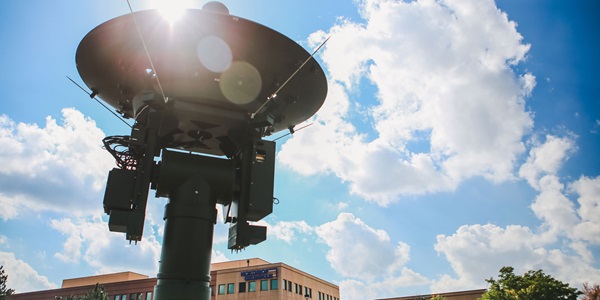When it comes to solving the mysteries of the universe, Northrop Grumman has pioneered groundbreaking technologies from the very beginning.
FPA
JSS component is missing React implementation. See the developer console for more information.
By Michelle A. Monroe
Currently, the United States is the dominant force in space, with more satellites than any other country. Earlier this year, though, Russia and China announced plans to increase their presence and power in space. That means our adversaries will have greater opportunity to strike down U.S. spacecraft and disrupt the flow of data to Earth.
“We need the ability to keep operating even if a satellite is lost,” said Robert Harnden, a Northrop Grumman engineer. “Our team is creating that ability.”
The flow of data from space is changing dramatically, and, with the help of Northrop Grumman, the U.S. satellite system is changing with it.
We’re developing a first-of-its-kind space router for satellites called Hydrant that will enable the transfer of data to Earth from anywhere in orbit, even if a satellite in a constellation is lost or destroyed.
Fleets of Connected Satellites
In the past, most satellite systems were connected directly to the ground but not one another. That’s not the case anymore, as America is shifting toward fleets of connected satellites that will interact and move data over multiple orbits. This requires many smaller satellites — a proliferated space architecture — in low-Earth orbit, operating on a network.
In low-Earth orbit, satellites pass so close to the Earth they can’t always see the same location on the ground, so they need to relay information to whichever satellite is closest to the ground station. Networking between satellites is important because if something disrupts a satellite in space, there is another one to pick up the signal and send information to where it’s needed.
“This on-board processing is possible only because of the software and hardware we’re building,” Robert said.
Data in Space
Much like terrestrial routers do for the internet, Hydrant will enable data to flow at high speed in space. If there is a satellite disruption, the networking system will sense the disruption.
“If we lose any type of connectivity in the network, the delay could be disastrous for people on the ground who need real-time information,” explained Faris Faris, a Northrop Grumman engineer and the principal investigator on Hydrant. “The ability for the network to route around any disruption and do that autonomously – to keep providing data to the ground – is a big deal. Northrop Grumman is leading the charge on this.”
Hydrant routers are Class-A network routers, which are the most difficult to make and have the longest required lifespan. In December 2023, we connected two prototype Hydrant routers using lasers instead of traditional radio frequencies to send data. As a test, we blocked the link with a piece of cardboard. The network successfully detected the block and routed around it to send the data on a different path. When we removed the cardboard and restored the link, the software automatically detected the change and rerouted the data back on the lasercomm link.
“I’m very proud of the team,” Faris said. “This is a complex technology and they have worked together well and seen success. This technology will have a positive impact on national security and reaching this milestone is a cause to celebrate.”
Learn more about our work in communications satellites, and if you’re interested in defining possible with us, explore what life’s like at Northrop Grumman.


